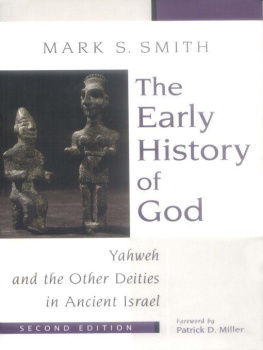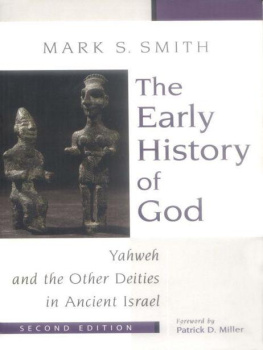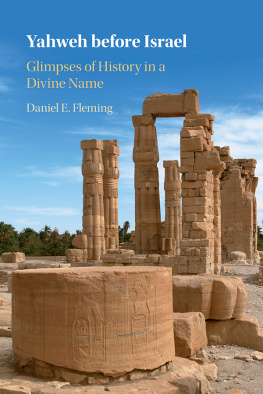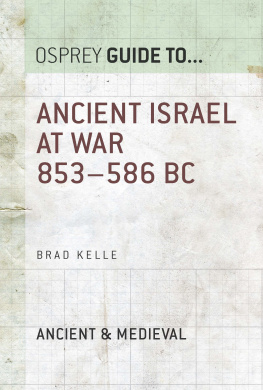THE ORIGINS OF BIBLICAL MONOTHEISM
Israels Polytheistic Background and the
Ugaritic Texts
Mark S. Smith


Oxford New York
Athens Auckland Bangkok Bogota Buenos Aires Calcutta
Cape Town Chennai Dar es Salaam Delhi Florence Hong Kong Istanbul
Karachi Kuala Lumpur Madrid Melbourne Mexico City Mumbai Nairobi
Paris Shanghai Singapore Taipei Tokyo Toronto Warsaw
and associated companies in
Berlin Ibadan
Copyright 2001 by Mark Smith
Published by Oxford University Press
198 Madison Avenue, New York, New York 10016
Oxford is a registered trademark of Oxford University Press
All rights reserved. No part of this publication may be reproduced,
stored in a retrieval system, or transmitted, in any form or by any means,
electronic, mechanical, photocopying, recording, or otherwise,
without the prior permission of Oxford University Press.
Library of Congress Cataloging-in-Publication Data
Smith, Mark S., 1955
The origins of biblical monotheism : Israels polytheistic background and the Ugaritic
texts / Mark S. Smith.
p. cm.
Includes bibliographical references and indexes.
ISBN 0-19-513480-X
1. GodBiblical teaching. 2. Ugaritic literatureRelation to the Old Testament. 3.
Bible. O.T.Criticism, interpretation, etc. 4. Gods, Semitic. 5. Polytheism. 6.
Monotheism. I. Title.
BS1192.6.S555 2000
296.3110901dc21 99-058180
2 4 6 8 9 7 5 3 1
Printed in the United States of America
on acid-free paper
For Liz
To the nut grove I went down,
To see the fruit of the vale,
To see if the vines had blossomed,
If the pomegranates had bloomed.
Song of Songs 6:11
Acknowledgments
But I should have liked to write a poem strong
And beautiful as mercy, and as long.
Elliott Coleman, One Hundred Poems,
June Sonnets #6
This book was produced largely thanks to a fellowship at the Center for Judaic Studies of the University of Pennsylvania in 199798. During the year, which was dedicated to the topic of Israelite religion, I took up the fundamental question of what divinity is. My earlier book The Early History of God discusses many different deities, but it does not define the more basic issue of what divinity is. Nor does that book address the categories, structures, or characteristics of deities. For quite some time I had given thought to this area of inquiry so that when I was given the opportunity to spend a year at the Center for Judaic Studies, I selected it as my topic. This book is the basic result of my years research at the Center. So before I offer any other acknowledgments, I am happy to thank the director of the Center, Professor David Ruderman, the Associate Director, Dr. David Goldenberg, and all the staff and fellows at the Center for Judaic Studies for contributing to an enjoyable and stimulating year. They helped me in so many ways with the work represented by this book. My thanks go in particular to a co-fellow, Professor Ted Lewis, for reading the entire manuscript and offering detailed comments. His remarks greatly improved this study.
. I have deeply appreciated the great interest he has taken in my research, both on this subject and other projects.
draws on current research on pertinent Mesopotamian textual and iconographic material, especially the mouth-opening (pit p) and mouth-washing (ms p) rituals. I am hardly a specialist in Mesopotamian religion and texts, and here I have been particularly guided by the research of Michael Dick and Victor Hurowitz. Professor Dick placed some of his unpublished work on the subject at my disposal; this work has fortunately appeared in print. All of these chapters in this book represent an effort at synthesis; accordingly, it is deeply indebted to the work of many scholars.
I also wish to expression my deep appreciation to the institutions in Jerusalem that supported my research. I am grateful to the Hebrew University of Jerusalem. Much of the groundwork for this study was laid in the summer of 1997 when I served as a Lady Davis Visiting Professor there. I thank the university and its many faculty who took an interest in my work, especially Professors Avi Hurvitz and Shalom Paul for their sponsorship. The staffs at the William Foxwell Albright Institute and the cole Biblique were gracious to me, and I benefitted many times over for their generosity. The library staffs at these two institutions deserve special note. At home, Saint Josephs University was exceptionally supportive in all of my presentations. I am especially grateful for the support given me by the chair of the Department of Theology, Professor Paul Aspan, and by the Dean of the College of Arts and Sciences, Professor Judi Chapman. The interlibrary loan staff at Drexel Library of Saint Josephs University has worked overtime to acquire all of the exotic items I have requested; I am happy to thank all of the library staff for their generosity and good humor, in particular Mary Martinson, Patrick Connelly, Rebecca Reilly, and Naomi Cohen. I am very much indebted to the many students who worked with me on the course on Israelite religion. Over the past five years, this course has increasingly taken up the themes of this book. Saint Joes students often served as the first sounding boards for my material. They asked questions that helped me to keep clarifying the evidence and the analysis. In 199495 and 199899 I taught Ugaritic at the University of Pennsylvania. My thinking benefitted from my reading of some of the Ugaritic texts treated in this book. I thank two scholars who sent me copies of their dissertations, Dr. Terje Stordalen of the Lutheran School of Theology in Oslo, and Dr. Lourik Karkajian of the University of Montreal. I am also pleased to acknowledge the support and warm reception by new colleagues at New York University, especially Dan Fleming and Larry Schiffman. Finally, I am grateful to Oxford University Press for publishing this book, and to its staff, especially Cynthia Read and Robert Milks, for shepherding it through the publication process.
I close this list with mention of two people who have been instrumental to my happiness. The topic of divinity was Marvin Popes lifelong passion, and in retrospect his spirit very much permeated my days working on this book. Many readers will recognize Marvins guidance both in his writing and teaching, and I am happy to acknowledge my debt to him (still, always). Finally, I dedicate this book to my wonderful wife, Liz. As my fellow fellow at the Center for Judaic Studies in 199798, she accompanied me along the way through this book, and her presence through our years together is a rare and irreplaceable companionship, at once personal and intellectual. Our secret garden (as our daughter Rachel calls it) winds down the side of our house and into our small, secluded backyard; it is hardly the only echo of our life that I hear in Song of Songs 6:11.
Department of Hebrew and Judaic Studies
M. S. S.
New York University
July 2000
Contents
Abbreviations, Terms, and Sigla
The abbreviations, listed in Journal of Biblical Literature 107 (1988), 58496, and The Assyrian Dictionary, Volume 15 S (ed. E. Reiner et al.; Chicago: Oriental Institute, 1984), viixxii, are used with the following additions, changes, and sigla. Second Temple works besides the Dead Sea Scrolls cited in this study may be found in James H. Charlesworth, ed.,













